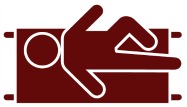At last week's Northwest States Trauma Conference, Dr. Richard Harper reviewed some great data and new thinking about airway management in full cardiac arrest. Harper is an associate professor at OHSU for emergency medicine and on the National Education Sub-Committee for the American Heart Association and this is some of the data AHA is taking into account for the 2010 ACLS guidelines.
For lay rescuers AHA has already gone to a hands-only CPR. Better to circulate the residual oxygen with compressions that lose precious time trying to increase the percentage of oxygen in the lungs. That, and even people trained in CPR hesitated to go face to face with a stranger.
For professionals, however, the bag valve mask is still the preferred ventilation method early on in cardiac arrest, Harper said. Looking at intubation success rates, Harper reported a 31 percent failure rate for prehospital intubation with about 12 percent unrecognized esophageal intubation on arrival a the hospital. Interestingly, this study showed no difference in mortality between those with failed intubation and those who were successfully intubated on arrival. Does that mean a bad tube is just as good as a good tube? In some respect this supports the idea of just working the patient longer with a BVM, Harper said.
Yet, there are a lot of times where you have to take control of airway. Harper presented findings where experienced flight crews intubated using traditional ET tubes, King Airways and CombiTubes. It what sounded like a well controlled study, King Airways came out on top both in terms of success (100 percent vs 82 percent for the Combi and 69 percent for the ET) and in time to placement. It took medics only 27 seconds to place a King compared to 53 seconds for the Combi and 91 seconds for the ET tube. (JEMS has a review of the study and a critique HERE and HERE.
Harper also reviewed the literature on the use of fiber optic devices vs. traditional laryngoscope. The new fiber optic laryngoscopes (Glidescope and Pentax Airwayscope) have a higher success rate than direct visualization and also create much less angulation of the c-spine than with traditional blades because the MD or medic doesn't have to move the head of the patient to visualize the cords.
Finally Harper reviewed a study comparing bougies ... finding that there is a brand difference when it comes to maintaining spinal stabilization. Frova and Eschmann proved superior introducers - particularly when compared with a glidescope.
And if the patient comes in with a King Airway? Just deflate that big 30 cc balloon and use your glidescope and Eschmann bougie to slide that ET tube into place!
Who needs to be intubated?
If the GCS is 8 you must intubate is the matra we've all heard both in prehospital and in the emergency room. However, Harper emphasized that a lower GCS does not always mandate intubation.
"Certainly in trauma, yes, but for other causes of lowered GCS it's not clear," Harper said. "Drugs and alcohol -- poisoned patients -- a lower GCS does not mandate intubation."
Alcohol can be a major cause of lowered GCS scores but can also result in more rapid recovery without intervention, Harper said.
Assessing the extent of inebriation is really not why the Glascow Coma Score was created, and I really wish we had a better tool to apply to these patients to help us determine when intervention is needed. Most of the time, we make sure they can protect their airway and let them sleep it off.
Search This Blog
Subscribe to:
Post Comments (Atom)
If You Want to Make God Laugh...
Early on in the pandemic one of my daughters exclaimed "Covid ruins everything!" It became a running joke in our house, a bitter...

-
General Information about Burns One of the most painful injuries that one can ever experience is a burn injury. When a burn occurs to the...
-
Communications Communication is one of the most important tools in the medical profession. The better the communication, the better care ...
-
Droperidol / Inapsine is back in the Emergency Room. Is it safe? When I was a new nurse in the Emergency Room of a little coastal hospita...

No comments:
Post a Comment